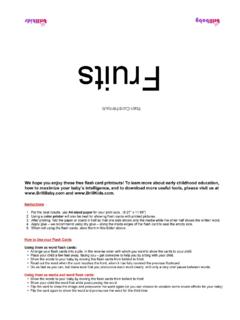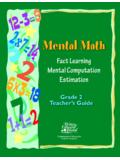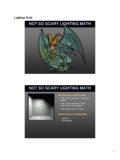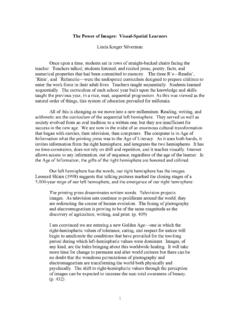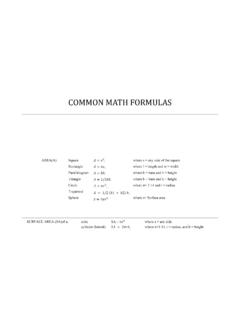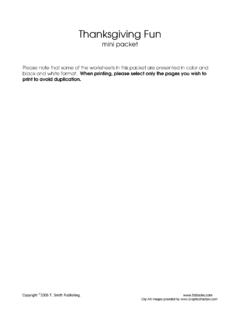Transcription of Teaching Your Young Child MATH - BrillKids
1 Everything you need to know about Teaching your Young Child math . (from baby and up). Everything you need to know about Teaching your Young Child math . by Caroline Blumenthal 2012 BrillKids Inc. All rights reserved. Visit to learn more! TABLE OF CONTENTS. CHAPTER 1 .. 4 INTRODUCTION .. 4 CAN YOU REALLY TEACH math TO A Young Child ?.. 4 AND WHY WOULD YOU WANT TO? .. 4 CHAPTER 2 .. 6 WHY TEACH math EARLY? .. 6 BABIES CAN DO math .. 7 (FAR BETTER THAN ADULTS CAN) .. 7 IT'S EASY TO TEACH math (MUCH EASIER THAN IT USED TO BE) .. 9 Young CHILDREN LOVE LEARNING math !.. 10 CHAPTER 3 .. 11 PERCEIVING QUANTITY (SUBITIZING) .. 11 SUBITIZE THIS! .. 12 THE REALITY OF 13 WHEN DO I START? .. 14 CHAPTER 4 .. 15 FLASH METHOD .. 15 PHILOSOPHY (DOMAN) .. 16 PHILOSOPHY (SHICHIDA) .. 17 METHOD (DOMAN) .. 18 METHOD (SHICHIDA).. 22 CHAPTER 5 .. 25 COMPUTER-BASED LEARNING .. 25 COMPUTER-BASED math IS EASIER (FOR PARENTS) .. 26 COMPUTER-BASED math IS MORE FUN (FOR TODDLERS).
2 27 MAKING NUMBERS REAL FOR CHILDREN WHO CAN'T PERCEIVE QUANTITY .. 27 CHAPTER 6 .. 30 CONCLUSION .. 30 CHAPTER 1. INTRODUCTION. CAN YOU REALLY TEACH math TO A Young Child ? AND WHY WOULD YOU WANT TO? The possibility of introducing very Young children particularly infants - to mathematical concepts is an intriguing one, if you believe in right-brain learning. The work of right-brain educators Glenn Dornan and Makoto Shichida shows that very Young children can perceive quantity in a way not open to most adults. Children below the age of two and half can, for instance, tell that they are looking at 48 triangles - and not 49 or 47. They can do this without counting or guessing. To find out more about this amazing natural ability and what it means for your Child 's math lessons, go to Chapter 3: Perceiving Quantity (Subitizing). Ready to get started Teaching your Young Child ? Head directly to Chapter 4: Flash Method, which covers the Doman and Shichida methods, or Chapter 5: Computer-Based Learning, which describes how you can teach your little one using PowerPoint slideshows or BrillKids ' own Utile math Learning System.
3 The school system is not geared to teach mathematics as well as it should be taught. The proof is that far too many people leave school with the conviction that they are "no good". at math . This state of affairs may be the norm, but it is far from acceptable. Indeed, the importance of math as a core subject and life skill can hardly be overstated. At BrillKids , we believe that any Child of average IQ can grow up feeling at home with numbers and numerical concepts. Just as the gift of early literacy can give children a lifelong love of reading, early math literacy can virtually ensure children leave school with a high level of confidence in their own mathematical ability. CHAPTER 2. WHY TEACH math EARLY? Doing math is one of the most important functions of life, since daily it is vital to civilized human living. From childhood to old age we are concerned with math . The Child in school is faced with mathematical problems every day, as are the housewife, the carpenter, the businessman and the space scientist.
4 Glenn Doman, educator and specialist in Child brain development It has been argued that math is the only truly universal language and it's easy to see why. Mathematics is the language of logic and reasoning; it is the language of pattern and symmetry. Mathematics brings order out of the apparent randomness of life. Mathematics is beautiful. For those of us who have never studied advanced mathematics, popular science books and TV programs provide windows into a world that keeps mathematicians and physicists enthralled their entire lives. Even if we may never experience the elegant intricacies of advanced mathematics, it's easy to appreciate how powerful a deeper understanding of mathematics can be. How do people fly to the moon and back? How does a bridge remain stable, even during the fiercest hurricane or typhoon? How does the heating or air conditioning system know when to shut off and start up again in order to keep the room at a constant temperature?
5 All of these things depend on mathematics. Mathematics is at the heart of everyday life. Whether or not your Child becomes comfortable with the subject is not something that should be left to chance. We're not saying your Child should grow up to be a mathematician, physicist or engineer - or even that by Teaching your Young Child math you will increase the chances of that happening. What we are saying is that it is within your power as a parent to endow your Child with a positive attitude to mathematics - as well as the capability to use math to her advantage in everyday life. It may be too late for some of us to ever become truly fluent in the language of math . But for our Young children, with their ability to absorb so much, the world of mathematics is their oyster! BABIES CAN DO math . (FAR BETTER THAN ADULTS CAN). If you give [tiny kids] the facts, they ll deduce the laws that govern them. That is exactly the same method that scientists use to discover laws.
6 Glenn Doman, educator and specialist in Child brain development While the gift of early literacy is one of the greatest gifts you can ever give a Child , it could perhaps be even more important to teach mathematics early. While a Child may end up being a good reader even if taught from the age of five or six, there is a certain type of math Teaching that - for it to be guaranteed to be successful - must be started before the age of two and a half. In children under the age of two and a half (and some slightly older children), right-brain dominancy gives the ability to "subitize" large quantities - that is, to instantly perceive how many items are in a relatively large set, without counting or guessing. For more on this, go to Chapter 3: Perceiving Quantity (Subitizing). As a parent, you can make use of this natural ability in your very Young Child to leach him about the true nature of quantity. The Doman and Shichida math programs begin by Teaching numbers as quantities, rather than the symbols (1, 2, etc.)
7 Used to represent them. Understanding numbers in this way enables children to instantly "see" the solutions to equations involving addition, subtraction, multiplication and division. And while the ability to subitize large quantities fades as children grow older, the ability to do instant math need not. Even when children are over the age of two and a half and can no longer subitize large quantities, there is still a great deal to be said for beginning mathematics at an early age. Quantity recognition can still be taught - but with quantities presented on a grid rather than in a random formation. For example, presenting the number 16 like this . makes it easy to tell that there are 15 items, almost as quickly as if there were only 5 items. The Child who understands quantity before she begins learning equations begins her mathematical education on a much more solid footing than the Child who does so being familiar only with the symbols used to represent numbers.
8 IT'S EASY TO TEACH math (MUCH EASIER THAN IT USED TO BE). Traditionally, Teaching math to Young children using the flash method requires a very big commitment on the part of parents. Some programs involve Teaching six or nine times a day - something that is impossible for parents who work full-time. A fair amount of preparation is also involved. Luckily there are now mathematics programs for children that are designed to be used just once or twice a day - a frequency most parents can maintain. Some, like BrillKids ' Little math Learning System, even provide the lesson materials and curriculum for you. All you need to do as a teacher is sit down at the computer with your student and press play! Another factor that has sometimes made it difficult for parents to teach has been the need to sustain a Child 's interest in her lessons. While most Young babies love seeing dot cards, problems can arise when parents first introduce the cards to an active toddler.
9 Little math is designed to enable you to import or create icons images and icons of animals, insects and cartoon characters - that will appeal to your Child 's particular interests. For many parents, customizable, varying icons have made all the difference in keeping lessons fun and fresh for their Child . Young CHILDREN LOVE LEARNING math ! Although we left it till the end, this is actually the most important reason of all for Teaching your Young Child math . Kids at a very Young age love learning about quantity, and they love seeing equations as long as both of these concepts are presented in a fun, happy way. If you use your toddler's favorite animal or cartoon character for your Little math lessons, it won't take long for your Child to start asking to see them on a regular basis - probably more often than you had planned to show them! What's more, children who begin understanding mathematics at an early age are immensely proud of their achievements.
10 All of us feel great when we know the right answer to something. Perhaps no other subject makes such clear distinctions between right and wrong as mathematics. Mathematics lessons have always been good for Young children. The difference now is that these lessons look as fun as they possibly can and require as little preparation as possible, too. For parents at least, there has surely never been a better time than right now to teach math to their little kids. CHAPTER 3. PERCEIVING QUANTITY (SUBITIZING). To understand why we recommend beginning your Child 's math lessons before the age of two and a half, it is important to understand the concept of perceiving quantity - also known as "subitizing.". At birth, the right hemisphere of the brain is dominant over the left. This makes sense, as many autonomic functions - critical for a baby's survival - are governed by the right side of the brain. The left side of the brain, which governs rational thought, comes online much later which would explain why it is next to impossible to reason with a very Young Child .



